Dave's Place
Electrical Diagnosis for Standard Refrigerators
Before working with electricity, visit the Electrical Safety page.
Troubleshooting electrical problems in a standard refrigerator (one without circuit boards) is relatively simple as long as you know electricity must complete a circuit for something to work. A circuit is a loop beginning at a power source, passing through some sort of resistance (a light bulb, for example), and returning to the power source along a different path than it originated. Breaking this circuit will cause whatever it was that was supposed to work (the resistance) not to work. Switches and thermostats (a switch controlled by temperature) are designed to open and close a circuit.
You diagnose an electrical failure by testing for the presence of voltage at various points along the circuit. Naturally, you will need some sort of test apparatus to conduct the tests. A test bulb, of the right voltage, with wires or a volt meter will work. If you end up with voltage to the heat element and it doesn't get hot, it is bad.
A thermostat problem is usually a case where the thermostat is either stuck shut or stuck open. Testing the connections on the thermostat while in operation will give you the answer you need. However, consider the temperature inside the box before jumping to any conclusions. Should the contacts inside the thermostat be open or closed at the given temperature? Having someone rotate the thermostat knob from one extreme to the other can also be helpful. Also, the electric portion of a combination thermostat (gas and electric) can be considered the same as an electric only thermostat in the diagrams below.
Below are several generic wire diagrams to assist in troubleshooting. The diagrams are generic in the sense that specific junction blocks and connectors are not shown, but the basic flow of electricity is accurate. Also there are numerous variations on these basic models.
Element Configurations:
- Simple Circuit - Single 120VAC volt heat element
- Two Stage Element - 120VAC volt Heating Element (three wire)
- Three Wire Element - 12VDC / 120VAC heat element
- Two Heating Elements (12VDC and 120VAC) (also four wire elements)
- Two Heating Elements with relay (12VDC and 120VAC)
- Two Stage Element - 120VAC volt Heating Element (three wire)
Simple Circuit - Single 120VAC volt heat element
The diagram below is a simple circuit and shows a 120 volt only system. This would also pertain to a 12 volt only system, except of course the element would be a 12 volt element.
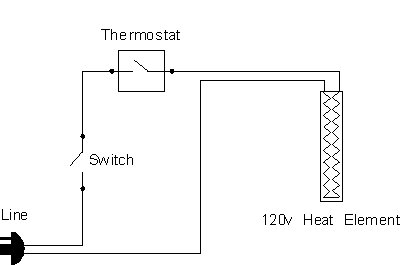
Two Stage Element - 120VAC volt Heating Element (three wire)
Below is a wire diagram with a two stage element. It's important to know that when the main switch is on, voltage is provided to the low heat side of the heat element. When the thermostat makes contact, it kicks in the high heat side.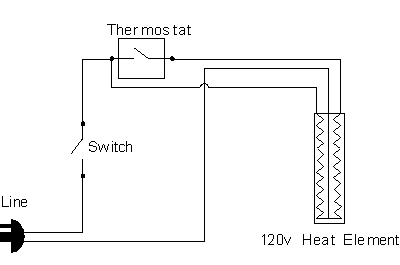
Three Wire Element - 12VDC / 120VAC heat element
Below is a 12VDC / 120VAC three wire element wire diagram. The common wire from the heat element is run through the thermostat. However, the selector switch is designed in such a way that the two voltages never make contact. The voltage passing through the thermostat is the currently selected voltage. If the situation arose, you could uses a 4 wire element (120v/12v) or two elements (one 12v and the other 120v) by tying a wire from each together to create a common wire.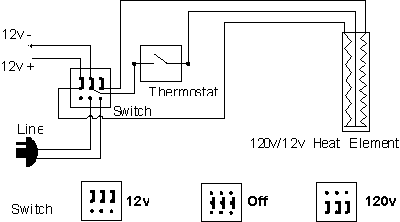
Two Heating Elements (12VDC and 120VAC) (also four wire elements)
Below is a two element wire diagram for separate 12 volt and 120 volt heat elements. This diagram will also pertain to a four wire 12 volt/120 volt element (just picture the two elements below as one unit with completely separate circuits for each voltage). For higher wattage 12 volt elements, see the diagram with the relay, farther below.
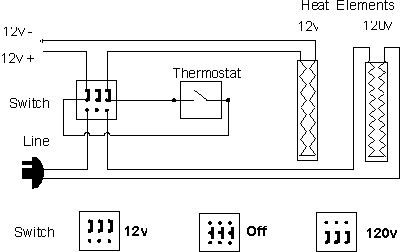
Two Heating Elements with relay (12VDC and 120VAC)
Below is a two element wire diagram with a relay to protect the thermostats for higher wattage12 volt elements. It should be pointed out that 12 volt is not very efficient for heating purposes. If left on, a 12 volt, high wattage element can drain a battery in a matter of hours and should only be used when the vehicle is running and charging the battery.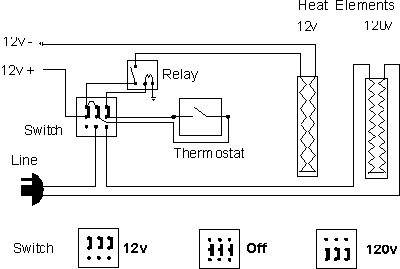
RV Refrigerator Home
This RV refridgerator information was originally located on rvmobile.comRV Mobile Inc. 11715 HWY 99, Everett, WA 98204
The owner of RV Mobile Inc. apparently suffered a heart attack and the original website was shut down.
It has been reposted here to preserve this wealth of information RV refridgerator information.